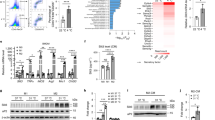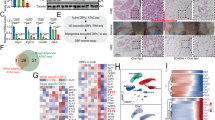Abstract
Adaptive thermogenesis is the process of heat generation in response to cold stimulation. It is under the control of the sympathetic nervous system, whose chief effector is the catecholamine norepinephrine (NE). NE enhances thermogenesis through β3-adrenergic receptors to activate brown adipose tissue and by 'browning' white adipose tissue. Recent studies have reported that alternative activation of macrophages in response to interleukin (IL)-4 stimulation induces the expression of tyrosine hydroxylase (TH), a key enzyme in the catecholamine synthesis pathway, and that this activation provides an alternative source of locally produced catecholamines during the thermogenic process. Here we report that the deletion of Th in hematopoietic cells of adult mice neither alters energy expenditure upon cold exposure nor reduces browning in inguinal adipose tissue. Bone marrow–derived macrophages did not release NE in response to stimulation with IL-4, and conditioned media from IL-4-stimulated macrophages failed to induce expression of thermogenic genes, such as uncoupling protein 1 (Ucp1), in adipocytes cultured with the conditioned media. Furthermore, chronic treatment with IL-4 failed to increase energy expenditure in wild-type, Ucp1−/− and interleukin-4 receptor-α double-negative (Il4ra−/−) mice. In agreement with these findings, adipose-tissue-resident macrophages did not express TH. Thus, we conclude that alternatively activated macrophages do not synthesize relevant amounts of catecholamines, and hence, are not likely to have a direct role in adipocyte metabolism or adaptive thermogenesis.
This is a preview of subscription content, access via your institution
Access options
Access Nature and 54 other Nature Portfolio journals
Get Nature+, our best-value online-access subscription
$29.99 / 30 days
cancel any time
Subscribe to this journal
Receive 12 print issues and online access
$209.00 per year
only $17.42 per issue
Buy this article
- Purchase on Springer Link
- Instant access to full article PDF
Prices may be subject to local taxes which are calculated during checkout






Similar content being viewed by others
References
Jastroch, M. et al. Seasonal control of mammalian energy balance: recent advances in the understanding of daily torpor and hibernation. J. Neuroendocrinol. 28 (2016).
Cannon, B. & Nedergaard, J. Brown adipose tissue: function and physiological significance. Physiol. Rev. 84, 277–359 (2004).
Oelkrug, R., Polymeropoulos, E.T. & Jastroch, M. Brown adipose tissue: physiological function and evolutionary significance. J. Comp. Physiol. B 185, 587–606 (2015).
Cypess, A.M. & Kahn, C.R. Brown fat as a therapy for obesity and diabetes. Curr. Opin. Endocrinol. Diabetes Obes. 17, 143–149 (2010).
Bartelt, A. et al. Brown adipose tissue activity controls triglyceride clearance. Nat. Med. 17, 200–205 (2011).
Nguyen, K.D. et al. Alternatively activated macrophages produce catecholamines to sustain adaptive thermogenesis. Nature 480, 104–108 (2011).
Qiu, Y. et al. Eosinophils and type 2 cytokine signaling in macrophages orchestrate development of functional beige fat. Cell 157, 1292–1308 (2014).
Thomas, S.A., Matsumoto, A.M. & Palmiter, R.D. Noradrenaline is essential for mouse fetal development. Nature 374, 643–646 (1995).
Hui, X. et al. Adiponectin enhances cold-induced browning of subcutaneous adipose tissue via promoting M2 macrophage proliferation. Cell Metab. 22, 279–290 (2015).
Hsieh, A.C. & Carlson, L.D. Role of adrenaline and noradrenaline in chemical regulation of heat production. Am. J. Physiol. 190, 243–246 (1957).
Bartness, T.J., Vaughan, C.H. & Song, C.K. Sympathetic and sensory innervation of brown adipose tissue. Int. J. Obes. 34 (Suppl. 1), S36–S42 (2010).
Rao, R.R. et al. Meteorin-like is a hormone that regulates immune-adipose interactions to increase beige fat thermogenesis. Cell 157, 1279–1291 (2014).
Lee, M.W. et al. Activated type 2 innate lymphoid cells regulate beige fat biogenesis. Cell 160, 74–87 (2015).
Fabbiano, S. et al. Caloric restriction leads to browning of white adipose tissue through type 2 immune signaling. Cell Metab. 24, 434–446 (2016).
Brestoff, J.R. et al. Group 2 innate lymphoid cells promote beiging of white adipose tissue and limit obesity. Nature 519, 242–246 (2015).
Merad, M. et al. Langerhans cells renew in the skin throughout life under steady-state conditions. Nat. Immunol. 3, 1135–1141 (2002).
Ginhoux, F. et al. Fate mapping analysis reveals that adult microglia derive from primitive macrophages. Science 330, 841–845 (2010).
Ussar, S., Fujisaka, S. & Kahn, C.R. Interactions between host genetics and gut microbiome in diabetes and metabolic syndrome. Mol. Metab. 5, 795–803 (2016).
Flierl, M.A. et al. Phagocyte-derived catecholamines enhance acute inflammatory injury. Nature 449, 721–725 (2007).
Ma, Y. et al. Extracellular norepinephrine clearance by the norepinephrine transporter is required for skeletal homeostasis. J. Biol. Chem. 288, 30105–30113 (2013).
Lavin, Y. et al. Tissue-resident macrophage enhancer landscapes are shaped by the local microenvironment. Cell 159, 1312–1326 (2014).
Koch, L. et al. Central insulin action regulates peripheral glucose and fat metabolism in mice. J. Clin. Invest. 118, 2132–2147 (2008).
Homann, D. et al. Lack of intrinsic CTLA-4 expression has minimal effect on regulation of antiviral T-cell immunity. J. Virol. 80, 270–280 (2006).
Tschöp, M.H. et al. A guide to analysis of mouse energy metabolism. Nat. Methods 9, 57–63 (2011).
Enerbäck, S. et al. Mice lacking mitochondrial uncoupling protein are cold-sensitive but not obese. Nature 387, 90–94 (1997).
Scholander, P.F., Walters, V., Hock, R. & Irving, L. Body insulation of some arctic and tropical mammals and birds. Biol. Bull. 99, 225–236 (1950).
Weir, J.B. New methods for calculating metabolic rate with special reference to protein metabolism. J. Physiol. (Lond.) 109, 1–9 (1949).
Livak, K.J. & Schmittgen, T.D. Analysis of relative gene expression data using real-time quantitative PCR and the 2(-Delta Delta C(T)) Method. Methods 25, 402–408 (2001).
Jaitin, D.A. et al. Massively parallel single-cell RNA-seq for marker-free decomposition of tissues into cell types. Science 343, 776–779 (2014).
Heinz, S. et al. Simple combinations of lineage-determining transcription factors prime cis-regulatory elements required for macrophage and B cell identities. Mol. Cell 38, 576–589 (2010).
Acknowledgements
We thank A. Fedl, L. Sehrer, L. Müller, S. Jall, D. Heine, T. Stankiewicz, K. Gaul and A. Stanley for assistance with in vitro and ex vivo analysis. The mice with floxed Th were kindly provided by R. Palmiter. This work was supported in part by funding to M.H.T. from the Alexander von Humboldt Foundation, the Helmholtz Alliance ICEMED & the Helmholtz Initiative on Personalized Medicine iMed by Helmholtz Association, and the Helmholtz cross-program topic “Metabolic Dysfunction.” This work was further supported by grants from the German Research Foundation DFG-TS226/1-1, DFG-TS226/3-1, SFB1123, Nutripathos Project ANR-15-CE14-0030, European Research Council ERC AdG HypoFlam no. 695054 (to M.H.T.); DFG He3260/8-1, the EU FP7 Network “DIABAT,” the EU ITN Network “TRAIN” 721531 (to S.H.); NIH R01 AA023416, DK082724 and a career-development award from the American Diabetes Association (to C.B.); NIH R01DK099222 (to S.D.); NIH DK17844 (to S.C.W.); the Israeli Science Foundation and European Research Council (AdvERC grant 340345) (to S.J.) and the Swedish Research Council and the Knut and Alice Wallenberg Foundation (to J.N. and B.C.). We would like to dedicate this manuscript to the memory of Tim Bartness, whose work delineates the important role of the SNS in adipose tissue function.
Author information
Authors and Affiliations
Contributions
K.F. co-conceptualized the project, designed and performed in vitro, in vivo and ex vivo experiments, analyzed and interpreted data and wrote the manuscript. B.F. and C.C. helped to design experiments and interpreted data. H.H.R., K.J., D.J.O., V.v.d.H., A.C.S. and D.H. performed, analyzed and interpreted the inducible THΔper mouse, validation of antibodies and BM chimera data. A.V.K. and N.P. performed, analyzed and interpreted in vivo experiments in Ucp1−/− mice. J.N. and K.-W.S. performed, analyzed and interpreted catecholamine data. Y.W. and S.J. performed, analyzed and interpreted tyrosine hydroxylase staining. F.B. generated the Il4ra−/− mouse. S.D., E.G., S.K., M.J., D.M., G.C., S.H., J.N. and B.C. helped to design experiments and interpreted data. S.C.W. helped with the interpretation of data and drafting the manuscript. M.H.T. co-conceptualized the project and interpreted all data. T.D.M. and C.B. co-conceptualized the project, interpreted all data, supervised the studies and wrote the manuscript.
Corresponding authors
Ethics declarations
Competing interests
The authors declare no competing financial interests.
Supplementary information
Supplementary Figures and Table
Supplementary Figures 1–12 and Supplementary Table 1 (PDF 21691 kb)
Rights and permissions
About this article
Cite this article
Fischer, K., Ruiz, H., Jhun, K. et al. Alternatively activated macrophages do not synthesize catecholamines or contribute to adipose tissue adaptive thermogenesis. Nat Med 23, 623–630 (2017). https://doi.org/10.1038/nm.4316
Received:
Accepted:
Published:
Issue Date:
DOI: https://doi.org/10.1038/nm.4316
This article is cited by
-
M2 macrophages independently promote beige adipogenesis via blocking adipocyte Ets1
Nature Communications (2024)
-
Unraveling the complex roles of macrophages in obese adipose tissue: an overview
Frontiers of Medicine (2024)
-
Local H2 release remodels senescence microenvironment for improved repair of injured bone
Nature Communications (2023)
-
Increased adipose catecholamine levels and protection from obesity with loss of Allograft Inflammatory Factor-1
Nature Communications (2023)
-
Heterogeneity of adipose tissue-resident macrophages-beyond M1/M2 paradigm
Diabetology International (2023)



